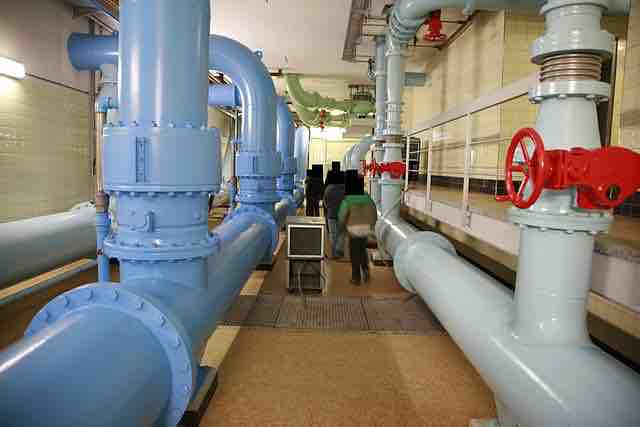Drinking Water Purification
In order to purify drinking water from a source (such as a lake, river, reservoir or groundwater), the water must go through several steps to remove large particles and different types of pathogens .

Drinking Water Purification
Water is purified for drinking through a system of filters and by chemical disinfectant.
- Pumping and Containment: Water is pumped from the source into holding tanks.
- Screening: Water is passed through a screen filter to remove large debris.
- Storage: Water is stored in reservoirs, tanks, and water towers in preparation for purification. Sometimes water is "pre-cholrinated" in this system to prevent bacterial growth while it is in storage.
- Coagulation and Sedimentation: Although there are many processes by which large particles are removed from drinking water, most water purification systems implement some kind of coagulation system. A chemical that causes particle aggregation is added to the water, and clumps of particles form and settle to the bottom of the reservoir. This is called sedimentation.
- Membrane Filtration: Membrane filters are able to remove all particles larger than 0.2 um. Larger pathogens such as giardia lamblia and cryptosporidium are trapped in these filters, but the cysts they produce are small enough to pass through.
- Disinfection: Before water is considered potable, it must be disinfected to remove any pathogens that passed through the membrane filter.
Methods of Disinfection
- Chlorination is the most common form of disinfection. Chlorine is a strong oxidant, and rapidly kills many microorganisms, especially bacteria. Because chlorine is a toxic gas, it can also be dangerous to sanitation workers. Chlorine based compounds like choloramine are often used. Although chlorine is very effective against bacteria, it is not as effective against the cysts formed by protozoans (like giardia lamblia and cryptosporidium). Chlorine can sometimes leave residual byproducts in water.
- Ozone is an unstable molecule that readily gives up one atom of oxygen providing a powerful oxidizing agent. This agent is toxic to most waterborne organisms. Ozone is widely used in Europe, and is an effective method to kill cysts formed by protozoans. It also works well against almost all other pathogens.
- Ultraviolet Light is very effective at inactivating protozoan cysts, and will also kill bacteria and viruses. However, it is not as effective in cloudy water. It is sometimes used in concert with chlorination.